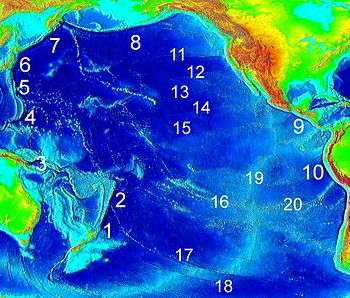Clipperton Fracture Zone
The Clipperton Fracture Zone, also known as the Clarion-Clipperton Zone,[1] is a geological submarine fracture zone of the Pacific Ocean, with a length of around 4500 miles (7240 km).[2] The zone spans approximately 4,500,000 square kilometres (1,700,000 sq mi).[3] It is one of the five major lineations of the northern Pacific floor, south of the Clarion Fracture Zone, discovered by the Scripps Institution of Oceanography in 1950. The fracture, an unusually mountainous topographical feature, begins east-northeast of the Line Islands and ends in the Middle America Trench off the coast of Central America.[2][4][5] It roughly forms a line on the same latitude as Kiribati and Clipperton Island.


In 2016, the seafloor in the Clipperton Fracture Zone – an area being targeted for deep-sea mining – was found to contain an abundance and diversity of life, with more than half of the species collected being new to science.[6] The zone is sometimes referred to as the Clarion-Clipperton Fracture Zone (CCFZ)[7], with reference to Clarion Island at the northern edge of the zone.
Geography
The fracture can be divided into four distinct parts:
- The first, 127°–113° W, is a broad, low welt of some 900 miles, with a central trough 10 to 30 miles wide;
- the second, 113°-107° W, is a volcano enriched ridge, 60 miles wide and 330 miles long;
- the third, 107°-101° W, is a low welt with a central trough 1,200–2,400 feet deep which transects the Albatross Plateau; and
- the fourth, 101°-96° W, contains the Tehuantepec Ridge which extends 400 miles northeast to the continental margin.[5]
The Nova-Canton Trough is often seen as an extension of the fracture.[8]
Deep sea mining
The zone, which is administered by the International Seabed Authority, contains nodules made up of various rare-earth elements. The zone has been divided into 16 mining claims spanning approximately 1,000,000 square kilometres (390,000 sq mi). Further nine areas, each covering 160,000 square kilometres (62,000 sq mi), have been set aside for conservation.[1] The International Seabed Authority estimates that the total amount of nodules in the Clarion Clipperton Zone exceeds 21 billions of tons (Bt), containing about 5.95 Bt of manganese, 0.27 Bt of nickel, 0.23 Bt of copper and 0.05 Bt of cobalt.[9]
References
- "DeepCCZ: Deep-sea Mining Interests in the Clarion-Clipperton Zone". NOAA Office of Ocean Exploration and Research. Retrieved 27 November 2019.
- "Clipperton Fracture Zone". Encyclopædia Britannica. Retrieved 17 November 2011.
- "The Clarion-Clipperton Zone". Pew Charitable Trusts. Retrieved 27 November 2019.
- Keating, Barbara H. (1987). Seamounts, islands, and atolls. American Geophysical Union. p. 156. ISBN 978-0-87590-068-1. Retrieved 17 November 2011.
- H. W. Menard and Robert L. Fisher (1958). "Clipperton Fracture in the Northeastern Equatorial Pacific". The Journal of Geology. 66 (3): 239–253. Bibcode:1958JG.....66..239M. doi:10.1086/626502. JSTOR 30080925.
- "Abundant and diverse ecosystem found in area targeted for deep-sea mining". EurekAlert. 29 July 2016. Retrieved 31 July 2016.
- https://www.isa.org.jm/clarion-clipperton-fracture-zone
- Contributions – Scripps Institution of Oceanography. Scripps Institution of Oceanography. 1972. p. 69. Retrieved 17 November 2011.
- International Seabed Authority (2010). A Geological Model of Polymetallic Nodule Deposits in the Clarion-Clipperton Fracture Zone and Prospector's Guide for Polymetallic Nodule Deposits in the Clarion Clipperton Fracture Zone. Technical Study: No. 6. ISBN 978-976-95268-2-2.